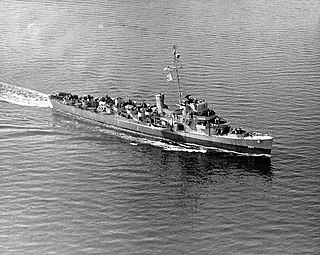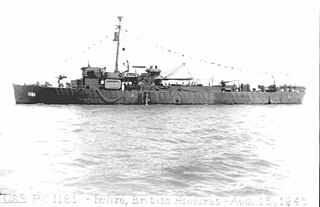
USS Bache (DD/DDE-470), a Fletcher-class destroyer, was the second ship of the United States Navy of that name. The destroyer was named for Commander George M. Bache.

USS Fox (DD-234/AG-85) was a Clemson-class destroyer in the United States Navy during World War II. She was the fourth ship named for Gustavus Vasa Fox, Assistant Secretary of the Navy during the Civil War.

USS Tillman (DD-641), a Gleaves-class destroyer, was the second ship of the United States Navy to be named for United States Senator Ben Tillman. In commission from 1942 to 1947, she saw service in World War II, primarily in the Atlantic and Mediterranean.

USS Sicard (DD-346/DM-21/AG-100) was a Clemson-class destroyer in the United States Navy following World War I. She was named for Montgomery Sicard.

USS Schmitt (DE-676) was a Buckley-class destroyer escort in the United States Navy, commissioned in 1943. In late 1944, she was converted to a high speed transport and was redesignated APD-76. She was retired in 1949 and transferred to the Republic of China Navy in 1969, where she served as ROCS Lung Shan (PF-44) until 1976, when she was scrapped.
USS Chickadee (AM-59) was an Auk-class minesweeper of the United States Navy, named after the Chickadee, a family of small passerine birds which appear in North America and Africa.

USS Hilary P. Jones (DD-427) was a Benson-class destroyer in the United States Navy during World War II. She was named for Admiral Hilary P. Jones.

USS Scott (DE-214), was a Buckley-class destroyer escort in service with the United States Navy from 1943 to 1947. She was scrapped in 1967.

USS Spangenberg (DE/DER-223), a Buckley-class destroyer escort of the United States Navy, was named in honor of Gunner's Mate Kenneth J. Spangenberg (1922-1942), who died as a result of wounds suffered during the Naval Battle of Guadalcanal, while serving aboard the heavy cruiser San Francisco (CA-38). He was posthumously awarded the Navy Cross.

USS Alexander J. Luke (DE/DER-577), a Buckley-class destroyer escort of the United States Navy, was named in honor of Sergeant Alexander J. Luke (1916–1942), who was killed in action during the attack on Tulagi on 6 August 1942. He was posthumously awarded the Silver Star.

USS Mason (DE-529), an Evarts-class destroyer escort, was the second ship of the United States Navy to be named Mason, though DE-529 was the only one specifically named for Ensign Newton Henry Mason. USS Mason was one of two US Navy ships with largely African-American crews in World War II. The other was USS PC-1264, a submarine chaser. These two ships were manned by African Americans as the result of a letter sent to President Roosevelt by the NAACP in mid-December 1941. Entering service in 1944, the vessel was used for convoy duty in the Battle of the Atlantic for the remainder of the war. Following the war, Mason was sold for scrap and broken up in 1947.

USS Huse (DE-145) was a U.S. Navy destroyer escort launched by Consolidated Steel Corp., Orange, Texas on 23 March 1943, during World War II. The ship was sponsored by Mrs. L. M. Humrichouse, daughter of Admiral Harry McLaren Pinckney Huse, whom the ship was named after and commissioned on 30 August 1943.

USS Andres (DE-45) was an Evarts-class destroyer escort constructed for the United States Navy during World War II. Sent off to the dangerous waters of the North Atlantic Ocean during the Battle of the Atlantic to protect convoys and other ships from Nazi Germany's Kriegsmarine U-boats and fighter aircraft, Andres performed escort and anti-submarine operations.

USS John J. Powers (DE-528) was an Evarts-class destroyer escort of the United States Navy during World War II. She was sent off into dangerous North Atlantic Ocean waters to protect convoys and other ships from German submarines and fighter aircraft. She performed escort and anti-submarine operations in battle areas before sailing home victorious at the end of the conflict.

USS Amick (DE-168) was a Cannon-class destroyer escort built for the United States Navy during World War II. She served in the Atlantic Ocean and then the Pacific Ocean and provided escort service against submarine and air attack for Navy vessels and convoys.

USS Jacob Jones (DE-130) was an Edsall-class destroyer escort built for the U.S. Navy during World War II. She served in the Atlantic Ocean and provided destroyer escort service against submarine and air attack for Navy vessels and convoys.

USS Sellstrom (DE-255) was an Edsall-class destroyer escort built for the U.S. Navy during World War II. She served in the Atlantic Ocean, the Pacific Ocean and provided destroyer escort protection against submarine and air attack for Navy vessels and convoys.

USS Jenks (DE-665) was a Buckley-class destroyer escort in service with the United States Navy from 1944 to 1946. She was scrapped in 1968.

USS PC-1181 was a PC-461-class submarine chaser built for the United States Navy during World War II. She was later renamed Wildwood (PC-1181) but never saw active service under that name.

USS Chaffee (DE-230) was a Rudderow-class destroyer escort in the United States Navy during World War II.



















